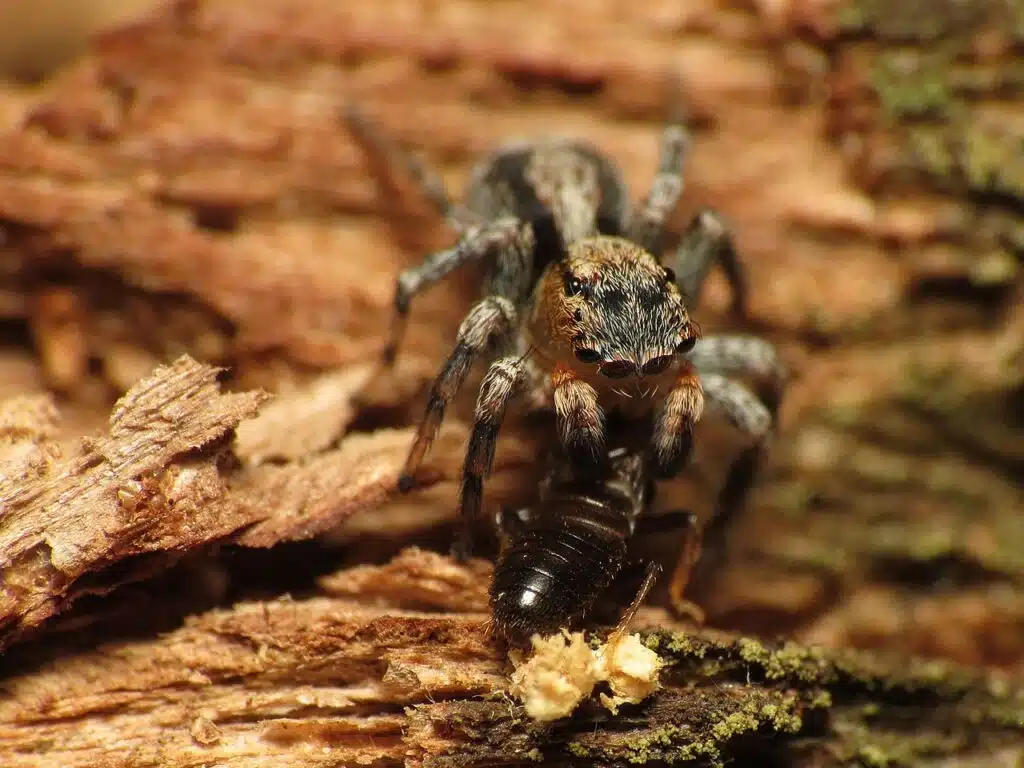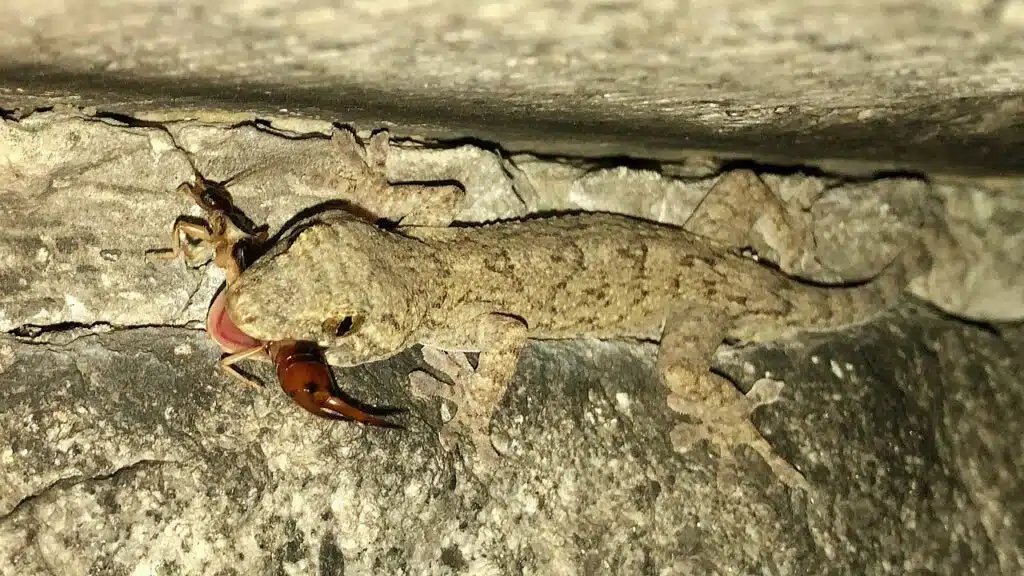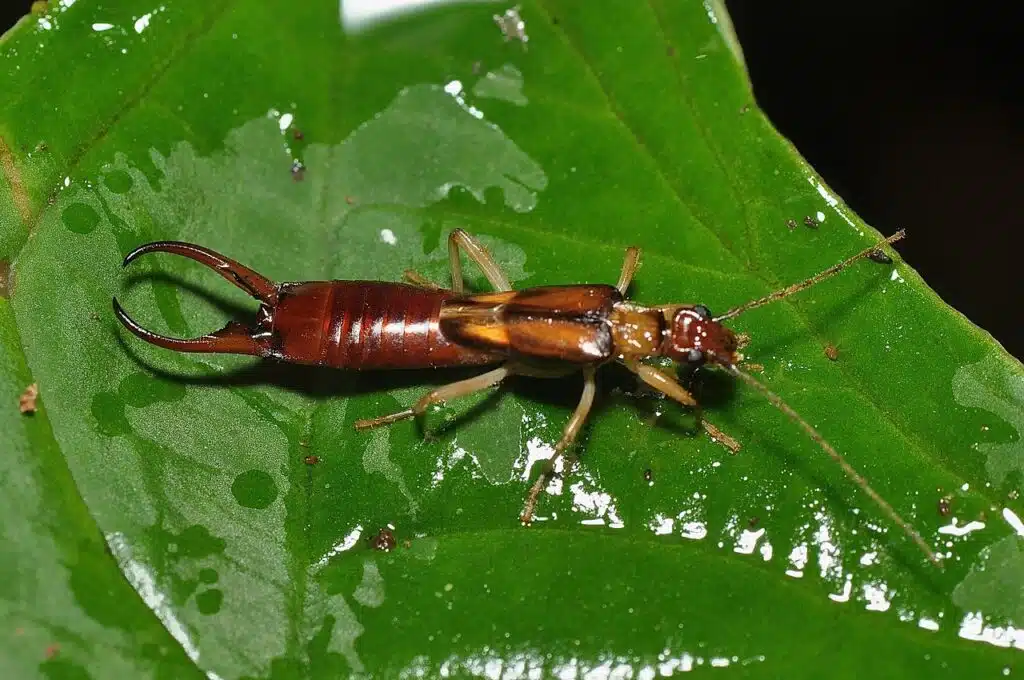Earwigs are some of the most common insects found around homes. Their popularity comes from their high numbers and their forceps-like pincers at the tip of the abdomen.
Earwigs eat plant matter and invertebrates while they’re also seen as ideal prey by a few other species.
Table of Contents
14 Earwig Predators
Birds and spiders are common species that eat earwigs. However, a few types of flies have been successfully used as biological control agents against earwigs.
Parasitic species are one of the unseen earwig predators. Parasitic flies or wasps lay eggs on or even inside earwigs, essentially killing them as larvae.
Earwigs might also eat other earwigs at times. While they prefer plant matter, earwigs have sometimes been known to attack members of their species.
The following species are the most common earwig predators.
1. Spiders

Not all spiders eat earwigs. There are a few species with intersecting habitats that may consume these bugs with pincers.
House spiders and wolf spiders are among the most common species that eat earwigs. These are spiders found around homes and gardens, often sharing the same habitat with earwigs.
Garden spiders also eat earwigs and earwig eggs.
Other types of spiders aren’t particularly interested in earwigs. Tarantulas are known not to prefer earwigs as a quick meal.
2. Birds
Birds are among the quickest and most efficient earwig predators. Small birds show a particular appetite for earwigs.
Common in parks, gardens, and on the edges of woodlands, small birds quickly grab earwigs transporting them to a safe place where they can be consumed.
Bluebirds and cardinals are among the species most commonly known not to miss an opportunity to eat earwigs.
Sharing the same habitat where moisture is prevalent, woodpeckers have also been shown to eat earwigs.
3. Chicken
Chickens eat almost any type of worm, insect, bug, or egg of bugs they can find around gardens.
Almost all types of chicken eat small or large earwigs.
Chicken tends to eliminate earwigs in their area.
Decaying vegetation, the main food source of earwigs is also known to be a good habitat for earthworms. Chicken actively seek out earthworks which means they also find earwigs.
4. Praying Mantis
Praying Mantises are efficient predators.
Found all around the world, Praying Mantises eat both flying insects and insects that move on the ground such as earwigs.
Strong front legs with a good grip help praying mantis bugs easily catch and hold earwigs that cannot escape their grip.
Camouflage and the capacity to stay still for hours allow ambushing techniques in praying mantises.
Further Reading:
5. Centipedes
Ground-dwelling insects such as centipedes also eat earwigs. Centipedes eat spiders and cockroaches which means they can easily chew softer earwigs.
Known for their many legs, centipedes share the same humid habitat earwigs love.
Both species are a common sight in the ground, specifically under mulch, an area with low water evaporation speeds known to house earwigs.
Further Reading:
6. Frogs and Toads
Frogs and toads also love high humidity, such as earwigs. Frogs are known for eating insects and they can be seen eating small earwigs.
Toads are even more successful against earwigs of any size.
Female toads tend to eat more. They can eat thousands of earwigs per year.
Marshes, ponds, and other habitats close to water or with high humidity are areas where frogs, toads, and earwigs coexist.
7. Lizards

Some types of ground-dwelling and arboreal lizards are known to eat earwigs.
They see earwigs from higher up on trees and they quickly move to catch these insects.
However, there are types of lizards such as anole lizards that don’t eat earwigs.
New data suggests some earwigs can release an unpleasant chemical or odor from their mouths when attacked by predators such as anole lizards.
This makes the lizards instantly spit earwigs out the mouth and move along.
8. Insectivorous Mammals
Small mammals are sometimes interested in eating earwigs, even if not as their main priority.
Moles are known to eat earwigs as they often share the same habitat. Both moths and earwigs are present in the substrate.
Moles can find earwigs under mulch or leaves. They aren’t particularly looking for earwigs as they are for any ground-dwelling insects such as grubs, snails, and various eggs or larvae.
Hedgehogs primarily eat earwigs, together with other bugs such as beetles. They look through the moist ground and decaying plant matter for earwigs.
9. Assassin Bugs
Assassin bugs can play a beneficial role in the ecosystem. These bugs eat earwigs as well as aphids and typical beetles.
Orange assassin bugs can eat small earwigs. Assassin bugs are even known for using dead insect parts to hide in and improve their camouflage.
Soft-bodied insects such as earwigs are among the favorites of assassin bugs. However, these bugs are mostly interested in even softer prey such as caterpillars.
10. Bats
Bats have a diverse diet that’s always subject to research. Some bats are known to eat earwigs as they can sometimes share the same humid environment.
Not all bats around the world are known to consume earwigs. European bats are the only species known to look for these bugs, mainly to supplement their diet.
11. Snakes
Snakes may also consume earwigs, depending on their species. Fossorial snakes are known to occasionally consume earwigs.
Garter snakes have also been reported to feed on earwigs.
These snakes also eat small frogs. Earwigs and frogs sometimes share the same habitat which means they could be part of a wider diet for these snakes.
12. Wasps
Multiple species of parasitic wasps are known to use earwigs as food for larvae.
Parasitic wasps use a host species to lay eggs in. Once the egg hatches, wasp larvae use earwigs for food.
Survival isn’t possible once the eggs have hatched. Ichneumon wasps are known to be one of the species that kill earwigs.
Females use their long ovipositors to lay eggs inside earwigs.
13. Tachinid Flies
Tachinid flies are some of the prevalent predators of earwigs. 2 main methods are used by these flies against earwigs.
Tachinid flies can lay eggs in areas with earwigs where they can ingest these eggs. These flies can also lay eggs on earwigs with glue-like substances.
Eggs use the host for food in both cases.
Multiple species of tachinid flies use earwigs as hosts. Some only use earwigs while most have a wider range of host insects.
14. Scorpions
Scorpions have varied diets based on their habitat. They can eat earwigs as they can also eat various species of spiders.
Scorpions also feed on cockroaches and ants.
Other prey is also considered by scorpions, but not as often. On occasion, scorpions can turn against each other. They can also feed on small lizards or mice.
How Do Earwigs Defend Themselves
Most people assume earwigs only use pincers to defend themselves. These small ground-dwellers also use strong abdominal secretions against predators such as birds.
Pincers against predators

Pincers are the most common method earwigs defend themselves.
The multipurpose role of pincers has sometimes led to the assumption earwigs don’t use them. Their pincers are used against predators.
Earwig pincers are also used to grab and hold prey.
Earwigs can have straight or curved pincers, depending on their gender. Both male and female earwigs use pincers against predators, mainly of a smaller size.
Abdominal secretions
Abdominal secretions with toxins and bad odors are used by earwigs against predators.
These secretions are believed to be the result of ingesting decaying plants from the ground. Abdominal secretions are only released when a predator approaches and not as a preventive attack measure.
Hiding (during the day)
Earwigs prefer to hide under rocks, leaves, and decaying wood during the day. They also hide under other objects and even under mulch.
Earwigs need shade for protection as well as humidity.
Sometimes found in basements, earwigs are only prone to hiding during the day as they come out at night looking for food.
Red-brown camouflage coloring
Most earwigs have a dark red-brown color. This means these bugs use their color to their advantage as they aren’t easily spotted on the ground.
Earwigs may be overlooked if not crawling.
Most earwigs don’t have wings and they need to hide or camouflage themselves as they cannot make a quick escape in case of an attack.
Even earwigs with wings prefer not to fly as they are very poor fliers.
Summary
Earwigs are routinely eaten by spiders, chickens, birds, and lizards.
Not all predatory species eat all types of earwigs since they can release abdominal secretions with a foul smell and a deterring effect.
Earwig predators are normally interested in a larger selection of ground-dwellers. Chicken and birds eat almost any type of bug or insect they can find.
Hedgehogs are among the few species that primarily feed on earwigs.
Some earwigs might also turn cannibalistic, eating other earwigs and their eggs.
However, since earwigs hide during the day, they have fewer natural predators compared to other bugs which are diurnal.
Earwigs by humans, especially in gardens, on mulch, or when found around the house.